English translation
Mending Body and Soul
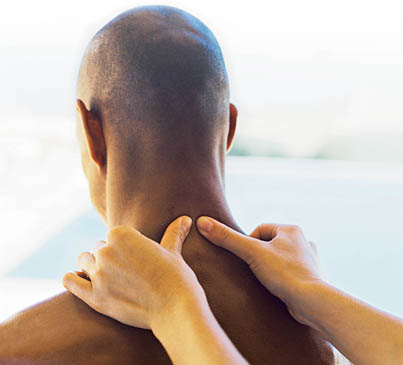
So where can you find hot tubs, massages and toned physiques on campus? McGill's Sport Medicine Clinic offers all that to ailing would-be Bruny Surins, along with the good spirits of a well-oiled team on a winning streak.
The clinic's tools of the trade include treatment tables, a trampoline, bouncy balls, an upper body reclining bicycle, weights and an elaborate-looking machine called the Biodex that measures muscle strength in more ways than you can shake a relay baton at. Colourful charts of the pathways of nerves and muscles make the innermost workings of the body comprehensible to lay people. There's a model skeleton, also assorted bones, a skull and a plastic foot revealing the layers of its anatomy.
The clinic is a melting pot of physiotherapists, athletic therapists, doctors, researchers, massage therapists and an osteopath. This diversity is one of its greatest strengths, as each consults with the others, constantly learning in a non-hierarchical environment. When Penny Lee, physiotherapist, wanted to better understand the torn anterior cruciate ligaments (ACL) of injured knees, a surgeon let her observe an operation.
"The whole idea is to get people rehabilitated as quickly as possible," says Mary Mooney, assistant clinic coordinator, as well as give them tips to lessen the chance of re-injury. "Usually you have to sit on the athletes to keep them from going back too soon," Mooney adds. "Even non-varsity types want to get back to doing what they love doing. They don't want to use it as an excuse to sit on the couch."
Mooney (who studied political science) finds her work uplifting. "All the students are enthusiastic. They're very disciplined in their sports and school." At McGill, brawn does go with brains. Students on varsity teams can't let their marks slip below 80 percent.
Students make up roughly 60 percent of the clients, staff from McGill and affiliated hospitals roughly 20 percent, and the community at large makes up the rest. The first person a client sees is usually James Hieminga, patient services coordinator, who spends time at the front desk on the phones giving out appointments but also dealing with family physicians, surgeons, and arranging tests like MRIs and bone scans. It's all part of the service.
Hieminga used to be the assistant coach for McGill's swim team and his keen interest in paramedicine (think of what ambulance technicians do) suits him well for the work. He also has a McGill opera degree and his tenor voice can be heard in the city's finer choirs. The music department often sends over music students suffering from repetitive stress injuries. Lest anyone think of musicians as soft-limbed aesthetes, not athletes, Hieminga tells me of a conductor who was so musclebound that his dislocated shoulder had to be put back in surgically.
Penny Lee says physiotherapists are basically "movement specialists," often found in hospitals, burn units, geriatrics, or helping kids with cerebral palsy. They work with stroke patients who have trouble buttoning up their shirt in the morning, or with incontinent people on strengthening their pelvic floor, or with a new mom who wants to nurse comfortably but is having shoulder pain.
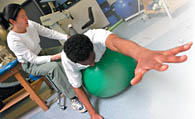
"When dealing with the general public, you see a lot of people who have never exercised. It's not part of their routine," Lee says. Working in the McGill clinic means dealing with athletes who "are used to training, working, and all have a goal to return to." Last year, a hockey player with a herniated disc took only five weeks to get back to the game due to diligently following the recommended exercises.
Lee runs and plays ultimate Frisbee and occasionally needs a bit of physiotherapy herself. So, does she do her exercises religiously? "We're still human, too," she laughs.
The physiotherapists also work with different varsity teams, where they have to make quick decisions whether a hurt player can get back in the game or not. Laura Abbatiello, physio- and athletic therapist, is the rookie of the team, at McGill for just over a year. In the fall, after a day of seeing about a dozen patients, she heads to football practice Monday to Friday, in addition to the Saturday games. She tapes up the players from 5:30 to 7:00, and directs four BSc Physio students. "We always have a slew of injuries," so there's plenty to tape, she says, as well as taping ankles or wrists for support.
The worst injury she's seen was a broken jaw at a game, but usually she deals with knee ligament tears, shoulder dislocations and the like. She all too vividly described the feeling of holding a guy's arm, deadweight, and feeling it being sucked back into the socket.
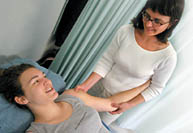
As if she isn't busy enough, she's doing an MSc in sports medicine. "I better have a backup plan for when my body breaks down," she jokes. "It's a very physical job! My first two weeks I thought 'I can't do this.'"
When I approached Caroline Lavoie, a physiotherapist and the clinic's osteopath, for this article, she was intently watching a young man on a profiter -- a gizmo he could balance on as he emulated the side-to-side swoosh of downhill skiing. She was checking the finer details of this nationally ranked athlete's movement to help him take his biomechanics to a perfect level.
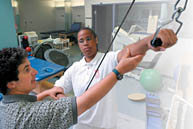
She also worked with the Montreal Alouettes football team in the past year. "I was a bit intimidated at first because they're big guys," she laughs. "It was a very fun environment, but I had to be focused on what I was doing and couldn't always participate in the joking around. And some wouldn't joke with me because I'm a woman."
Although the practice of osteopathy is better known in Europe, it's slowly becoming more popular here. Sometimes people come to her as a last resort, after trying other physical therapies. "That's a lot of pressure on my shoulders. Doctors send me the hard cases when they don't know what else to do," says Lavoie.
Marie-Claude Després turned down medical school to become a physiotherapist, "an engineer of the body," because she liked that "you use the hands to fix people. When you see patients, you visualize the joints, movements. You focus so much you forget who you are almost." Working out at the end of the day restores her sense of self.
Years ago she ran away to join the circus, touring North America for three years and Asia for two with the Cirque du Soleil. She cared for over 50 performers doing 10 shows a week. "I was the psychologist, physiotherapist, mother. When a problem happened, they'd come to me," she laughs.
The troupe included folks of varying cultures, ages, education, economic means -- from 12-year-old Chinese gymnasts to 35-year-old Russian acrobats -- and Després had to learn how to communicate with each of them. Together with more experienced performers, she taught them how to perform with an injury and not do further damage, something all top athletes learn.
She's seen that to get patients involved in the healing process, "there's a fire you need to light," she says, "a different button to press to motivate them and it's not the same with all patients."
More literally pressing buttons is Vonda Allan, one of the clinic's massage therapists. Her calm demeanour and welcoming blue eyes are no doubt appreciated by students who come to her at exam time with knots of tension in their upper backs.
We're all one interconnected bundle to a massage therapist. Chronic headache sufferers may find relief from Allan massaging a trigger point in the shoulder, something an MRI can't always detect. Her room is dimly lit and soothing nature scenes adorn the walls. A little portable waterfall tinkles and trickles.
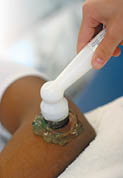
Also on the wall are her certificates in craniosacral system therapy and lymphatic drainage. She talks about all the fluids and systems in our bodies, their rhythms, secrets, how cerebral fluids have their own movement, like a closed hydraulic system. Lymphatic liquors flow in a one-way circulatory system that picks up waste. "If you have tension in your body, your lymphs will be sluggish."
The clinicÕs different strategies to optimize health result in a lot of happy customers. And if the clinicians can't help, they'll do their best to find someone who can. Hieminga says he's getting fat from all the cookies and cakes grateful patients bring in. "We get letters and phone calls all the time."
Recently, he heard good news from one 89-year-old client who'd had a fall, hurt his hip, and wanted nothing more than to be able to participate in a particular walk for charity. That the client accomplished his modest goal meant a lot to Hieminga.
"You may not be Lance Armstrong or Silken Laumann, but if we can get you back on the bike or in the boat, we will."


